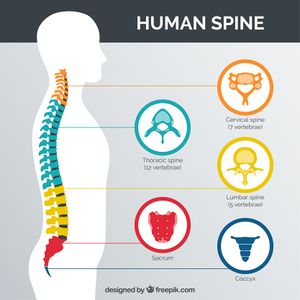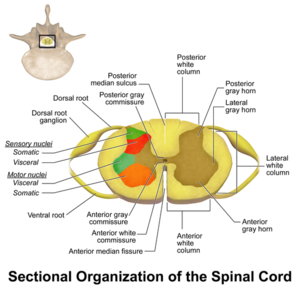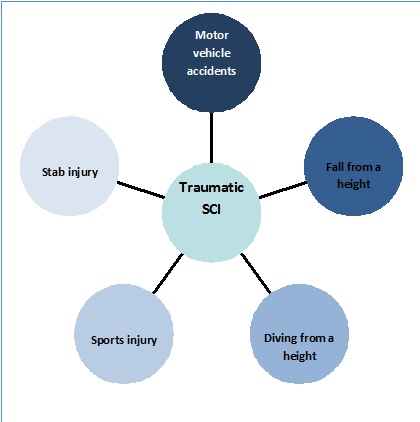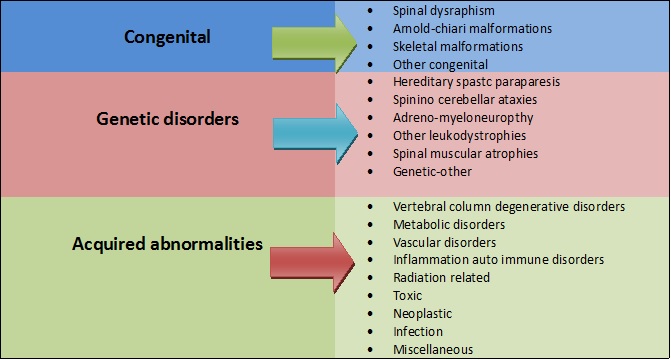Overview of Spinal Cord Injuries: Difference between revisions
No edit summary |
No edit summary |
||
| Line 23: | Line 23: | ||
<div class="row"> | <div class="row"> | ||
<div class="col-md-6">[[File:42282-O3EL6G.jpg | <div class="col-md-6">[[File:42282-O3EL6G.jpg|center|<ref>Designed by Freepik at http://www.freepik.com</ref>|300x300px|thumb]] | ||
<div class="col-md-6">[[Image:Spinal Cord Sectional Anatomy.png | </div> | ||
<div class="col-md-6">[[Image:Spinal Cord Sectional Anatomy.png|center|300x300px|thumb|<ref>[http://blausen.com/?Topic=360 Spinal Cord]. ''Blausen Medical''. Retrieved on 26 January 2016.</ref>]]</div> | |||
</div> | </div> | ||
Revision as of 01:20, 30 October 2018
- Please do not edit unless you are involved in this project, but please come back in the near future to check out new information!!
- If you would like to get involved in this project and earn accreditation for your contributions, [[[Special:Contact|please get in touch]]]!
Original Editor - Kudzanayi Ronald Muzenda
Top Contributors - Naomi O'Reilly, Kudzanayi Ronald Muzenda, Kim Jackson, Admin, Tarina van der Stockt, Rucha Gadgil, Jess Bell, Lucinda hampton and Ewa Jaraczewska
What is a Spinal Cord Injury [edit | edit source]
Spinal Cord Injury (SCI) is a sudden onset disruption to the neuronal tisue within the spinal canal resulting in spinal cord damage as a result trauma, disease or degeneration. [1][2] Injuries to the spinal cord are complex, and each individuals injury is unique in terms of the functions affected. It can present as either an upper motor neurone lesion or lower motor neurone lesion with varying loss of motor, sensory and autonomic function, either temporary or permanent depending on the level and type of injury to the Spinal Cord.[2][3] Classification of Spinal Cord Injury is conducted based on the degree of sparing of movement and sensation below the level of the Injury using the ASIA Impairment Scale. [4]
Paraplegia refers to impairment or loss of motor, sensory or autonomic function in areas of the body served by the thoracic, lumbar or sacral segments of the spinal cord. Depending on the level of the injury trunk, pelvic organs and lower limbs may be involved with upper limb function preserved.[1]
Tetraplegia, sometimes referred to as quadriplegia, refers to impairment or loss of motor, sensory or autonomic function in areas of the body served by the cervical segments of the spinal cord. This results in impairment in upper and lower limbs, trunk and pelvic organs with respiratory function impaired in those with high cervical injuries.[1]Clinically Relevant Anatomy[edit | edit source]
Th spinal column is comprised of 33 Vertebra; Cervical (7 Vertebrae), Thoracic (12 Vertebrae), Lumbar (5 Vertebrae), Sacral (5 Vertebrae) and Coccygeal (4 Vertebrae), which provide support and protection for the spinal cord. The spinal cord is the major conduit between the peripheral nerves and the brain, and transmits motor information from the brain to the muscles, tissues and organs, and sensory information from these areas back to the brain. [5][6]
The nervous system is divided into the central nervous system and (brain and spinal cord) and the peripheral nervous system (nerves that enter and exit the spinal cord. Information to and from the muscles, glands, organs and sensory receptors are carried through the peripheral nervous system, which is divided into the autonomic nervous system carrying information to and from the organs, and the somatic nervous system carrying information to and from the muscles and the external environment. [5] The autonomic nervous system consists of the parasympathetic nervous system that governs resting function and the sympathetic nervous system that governs excitatory functions. The spinal cord and peripheral nerves provide all impulses to control muscle contraction, cardiac rhythm, pain and other bodily functions so therefore any lesion to the spinal cord prevents of reduces transmission of this information to and from the brain to the peripheries, affecting movement sensation and visceral function. [6]
Epidemiology / Etiology[edit | edit source]
Causes of SCI can either be traumatic or non traumatic
Traumatic causes of Spinal Cord Injuries [9][edit | edit source]
The diagram below shows the traumatic causes of of SCI
Non-traumatic causes of Spinal cord injuries[10][edit | edit source]
The table below shows a summary of non- traumatic causes of SCI injuries
Management[edit | edit source]
Conservative Management[edit | edit source]
Surgical Management[edit | edit source]
Types of Spinal Cord injuries[edit | edit source]
Paraplegia
Rehabilitation of Spinal Cord injuries[edit | edit source]
References[edit | edit source]
- ↑ 1.0 1.1 1.2 Stack E, Stokes M, editors. Physical Management for Neurological Conditions. Elsevier Churchill Livingstone; 2012.
- ↑ 2.0 2.1 Harvey L. Management of Spinal Cord Injuries: A Guide for Physiotherapists. Elsevier Health Sciences; 2008 Jan 10.
- ↑ Tymianski, D., Sarro, A. Green, T. (2012). Navigating Neuroscience Nursing: A Canadian Perspective. 1st Ed. Pappin Communications, Pembroke, Ontario
- ↑ Kirshblum SC, Burns SP, Biering-Sorensen F, Donovan W, Graves DE, Jha A et al. International standards for neurological classification of spinal cord injury (revised 2011). J Spinal Cord Med 2011; 34: 535-546
- ↑ 5.0 5.1 Moore KL, Agur AM, Dalley AF. Essential Clinical Anatomy. Philadelphia: Lippincott Williams & Wilkins; 2002 Mar.
- ↑ 6.0 6.1 Francisco de Assis Aquino Gondim et al., Topographic and Functional Anatomy of the Spinal Cord, Medshape, 2015
- ↑ Designed by Freepik at http://www.freepik.com
- ↑ Spinal Cord. Blausen Medical. Retrieved on 26 January 2016.
- ↑ Ackery A, Tator C, Krassioukov A. A global perspective on spinal cord injury epidemiology. J Neurotrauma 2004; 21: 1355-1370
- ↑ Biering-Sørensen F, Charlifue S, DeVivo M, Noonan V, Post M, Stripling T, Wing P. International Spinal Cord Injury Data Sets. Spinal Cord. 2006 Sep;44(9):530-4.).










